What Is The Difference Between A Cherry Blossom And A Cherry Tree? If someone said that they had a cherry tree on their property, you might assume that they are picking fruit off the tree after it produced a blossom. Based on this it would be easy to assume that cherry blossom trees and cherry trees are the same thing but are they really?
Cherry Blossom Trees are different from cherry trees. The primary difference is that cherry blossoms are ornamental and produce beautiful blooms that are highly valued for their appearance but do not produce fruit. Cherry trees on the other hand have do produce fruit but they also produce flowers though, the flower display is not as vibrant. These edible varieties can be divided up into sweet types that can be eaten directly from the tree and sour types which are usually used for baking.
The cherry tree and the cherry blossom tree are both members of the same genus, Prunus, which also includes other stone fruit such as plums, peaches, nectarines, and apricots. Both types of cherry trees are widespread in the Northern Hemisphere in places such as China, Korea, the northern part of the Indian subcontinent, and Europe.
However, the cherry blossom trees are most widely associated with Japan, who conduct a nationwide celebration during the blooming season in late March and April. Typically, the flowering period only lasts 2 weeks, however, due to the climatic variations within the country, the precise timing of the celebrations varies by a few weeks in different parts of the country.
During this period friends and families meet in parks and picnic underneath the trees to celebrate the transient beauty of the flowers as a sign of the warmer weather ahead. This has been a tradition for over 1000 years in Japan with records showing that cherry blossom festivals, which is called Hanami in Japan became popular in the Heian Period which stretched from 794 to 1185. It was popularised when members of the Imperial court when they started hosting feasts under the trees.
About Cherry Blossum Trees
The cherry blossom tree, which is known as the Sakura in Japan, refers to just 7 different species. However, from these 7 species, there have been over 300 hundred different cultivars and hybrid varieties developed. These trees come in a range of sizes. However, they are most commonly divided up into 4 major groups based on the number of petals that they have. These groups are;
- Single Flower varieties that feature 5 to 8 petals per flowers.
- Semi-double flower varieties that typically have 10 to 20 petals per flower
- Double Flower varieties that contain 25 to 50 petals per flower.
- The Chrysanthemum flowers that typically have 100 petals per flower however there are varieties that have upto 300 petals per flowers.
In Japan, the most popular varieties are the single-flowered varieties, such as Yoshino (Prunus x yedoensis) which only has 5 petals per flower. These types of plants are generally considered to be more elegant plants by the Japanese which is a sentiment I personally share. An image of this variety is shown below.
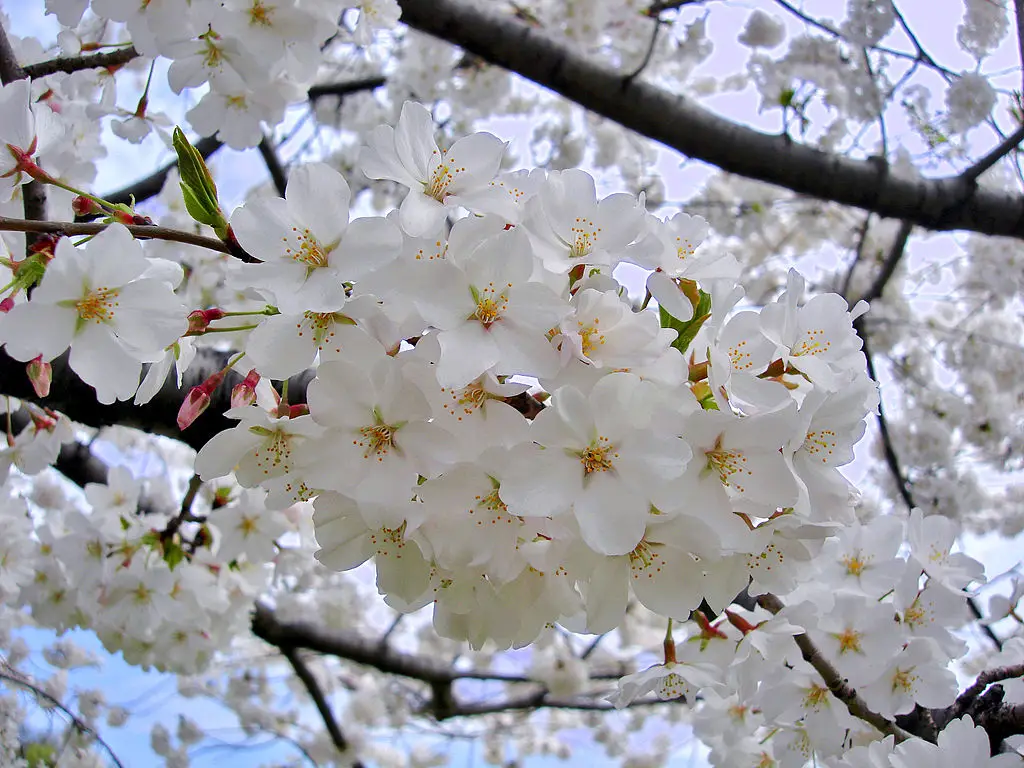
To show you what is meant by the elegance of fewer petals below is a photo of a relatively popular variety of a double bloom called Kanzan which has many more petals on each flower.
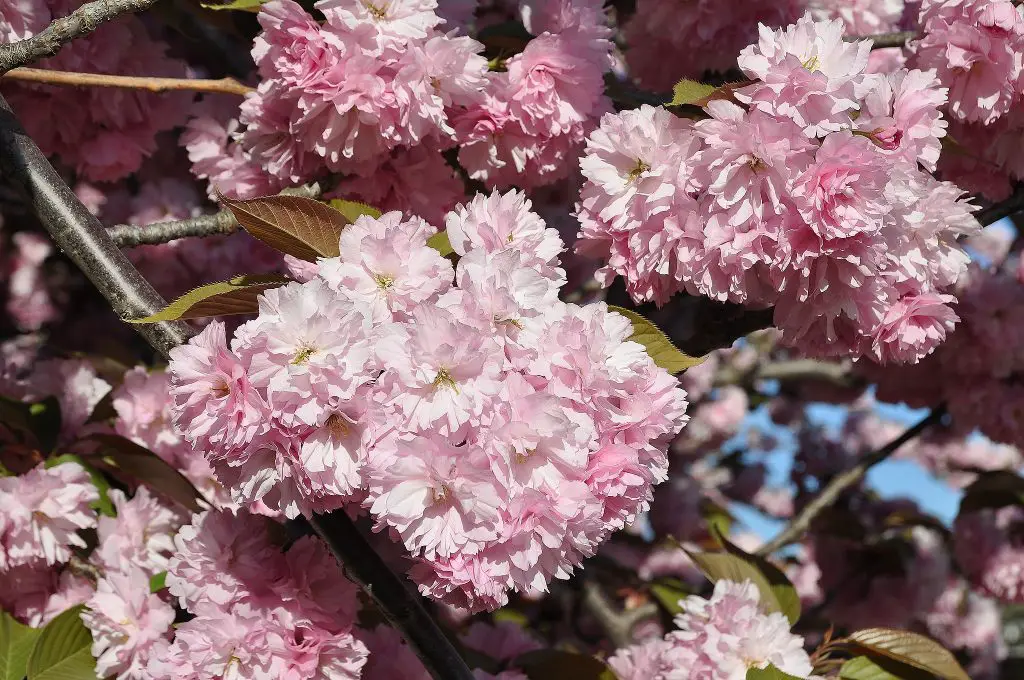
In terms of the color of the blossoms, the most common colors are white to light pink. However, many varieties start with a dark pink bud that lightens as they open up to a pale pink color. As they open up many of the varieties will produce a fragrant scent, however, when the weather is cold the fragrance reduces significantly.
As mentioned earlier in the article cherry generally bloom in the spring and will typically last only 2 to 3 weeks in places like Japan however, in warmer climates like the UK the blooming period is a little longer, in some cases extending to 6 weeks or so.
The blooming period does vary as with the particular variety being grown. Varieties such as Yoshino are an early spring bloomer whereas ‘Kazan’ is a late bloomer that will appear in the later parts of spring. In addition, the blooms produce cherry blossoms that provide interest in the garden in spring they also produce a wonderful autumn color from their foliage which most commonly turns to a golden yellow and sometimes red color depending upon the variety.
Cherry trees are a popular plant in home gardens because they are relatively small trees that require minimal care. Cherry trees are tolerant of a wide range of soil types and generally don’t need to be water a great deal once established. They are suitable for growing in zones 4 to 9 in most cases and really only need to be pruned occasionally to ensure that there is adequate air circulation to reduce the chances of fungal disease.
Fungal disease can appear in the form is powdery mildew, leaf spot, or leaf or blossom wilt. Should you encounter problems most diseases can be remedied with an application of a fungicide.
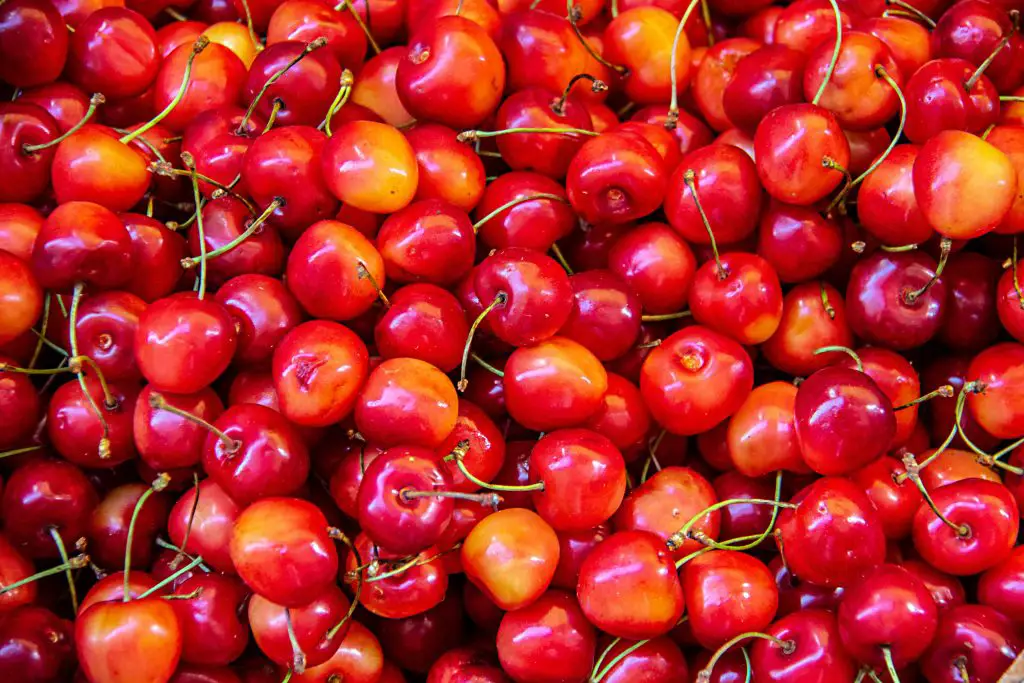
Cherry Fruit Trees
Fruiting cherry trees can be largely divided into 2 major groups, sweet cherry, and sour cherry which are suitable for growing in zones 3 to 10. However, sour cherry varieties are more cold-tolerant than Sweet Cherry varieties. The reason for this is that they flower later which limits the damage that can occur as a result of late frosts. The extent of damage can be reduced by providing frost protection. To read more about the temperatures that can be tolerated by the trees at different stages of bud and flower development click here.
The other limiting factor for growing fruiting Cherry trees is the need to be exposed to a period of cold in order for them to fruit successfully. The amount of time, which is sometimes referred to as chill hours varies depending upon the particular cultivar, which is shown in the table below.
| Chill Rating | Chill Hours | Examples Of Varieties |
| Low | 300‐500 | Brooks |
| low‐Moderate | 500‐750 | Lapins |
| Moderate‐high | 750‐1000 | Lapins, Sweetheart |
| High | 1000‐1500 | Sweetheart, Korida |
If this seems all too complex don’t worry there are a couple of simple strategies you can use to narrow down the Cherry variety to grow. The first is to simply have a chat with the local plant store. The varieties they are stocking will be suitable for your region, or alternatively, visit your local garden club to find out what varieties are being grown in your local area by other gardeners.
The other way is to estimate the number of chill hours in your location. To estimate this take the average temperature in your coldest month and compare it to the table provided below. With this information, you can look up varieties that fall within the right range for chill hours.
Chill Hours Average Temperature For Coldest Month
0 19.7°C (67.5°F) – No Chill
300 15.5°C (59.9°F) – Low Chill
330 15.3°C (59.5°F) – Low Chill
450 14.0°C (57.2°F) – Medium Chill
500 13.6°C (56.5°F) – Medium Chill
520 13.1°C (55.6°F) – Medium Chill
600 12.7°C (54.9°F) – Medium to High Chill
800 10.2°C (50.4°F) – High Chill
1100 7.9°C (46.2°F) – High Chill
1250 0.0°C (32.0°F) – Very High Chill
Do You Need More Than One Cherry Tree To Produce Fruit?
The need for a second tree for cross-pollination is dependent upon the variety. Sour cherry varieties are self-pollinated which means that they do not require more than one tree to produce the fruit. However, if you plant a sweet variety a second tree is required in most cases to get fruit but there are some exceptions to this. Varieties such Stella, which I have in my own yard can self-pollinate.
However, even though some varieties are self-pollinated they will still benefit from the presence of a second tree. This is because it generally improves the degree of pollination and therefore increases the yield from the tree.
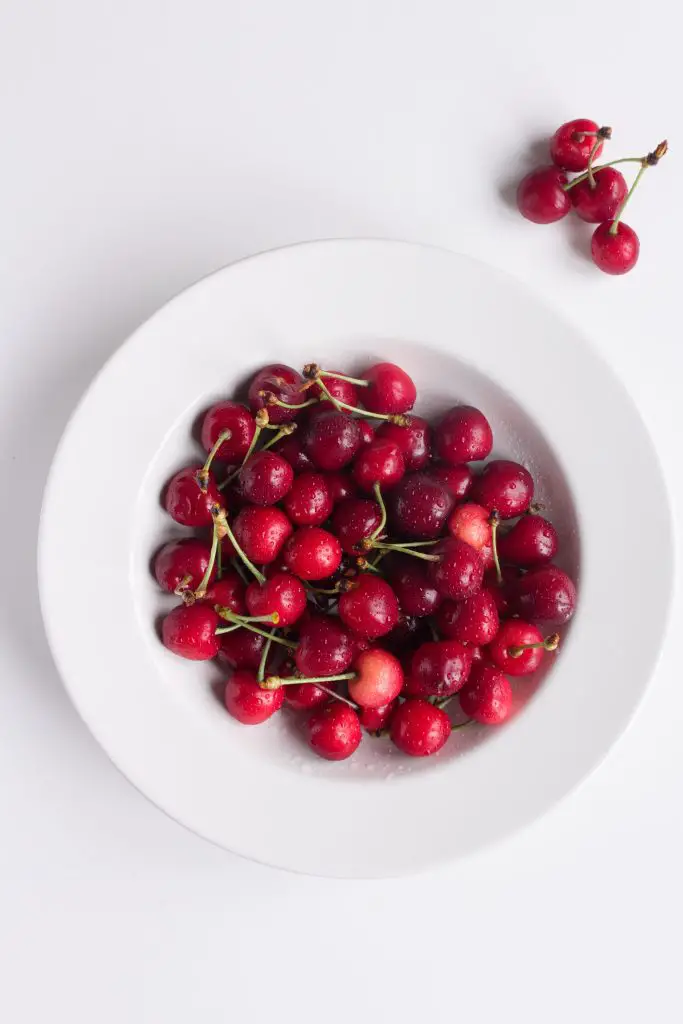
How To Plant A Cherry Tree
Cherry trees are best planted in late winter however, this is sometimes not practical if you live in a really cold climate where the ground freezes solid. In these cases, it may necessary to plant the trees a little later in the season.
The benefit of planting at this time of year is that trees can be purchased bare-rooted. Bare-rooted trees are usually significantly cheaper than potted trees. Additionally, it is common for retailers to reduce the price of these trees at the end of the bare-rooted season to help clear stock, so it is possible to pick up a real bargain.
Once the tree has been purchased the next step is to select a location to plant the tree. Ideally, Cherry trees should be planted in a warm sunny location that gets at least 8 hours of sun per day. However, if you are in a situation where your climate is on the border of being either too hot or cold for a particular variety, clever selection of a location can make a really big difference to how the tree performs.
In cases where you ideally need additional heat select a south-facing location (in the northern hemisphere), that is next to a brick wall as this will reduce the minimum temperature at night that the tree is exposed to. Alternatively, if your conditions are a little warm try to select a location that is shaded in the morning and only gets afternoon temperature. This will ensure that the tree remains in the shade during the coldest part of the day maximizing the tree’s chill hours.
The next important consideration is the quality of the soil, Cherry trees generally do not like wet feet. They prefer a well-drained soil that contains plenty of organic matter and is slightly acidic, a pH of 6.5 to 7.0 is ideal. To check the soil it is easiest to use a pH meter rather than pH strips and they usually provide a more accurate result. They are also lower in cost than pH kits, click here to see the latest price on Amazon.
Once the soil is prepared dig a hole and position the tree. The depth of the tree should be approximately the same depth as it had been previously been planted at. It is also important to make sure that the graft union of the tree is around 2 inches above the ground to avoid the root-stock-producing suckers.
Once the tree is positioned back-fill the hole with soil, firming the soil in as you go to ensure that there are no air pockets. Water the tree in well and then apply a thick layer of organic mulch, 2 to 4 inches is ideal. At this stage it is important to make sure that the mulch does not come into contact with the trunk, to avoid collar rot.
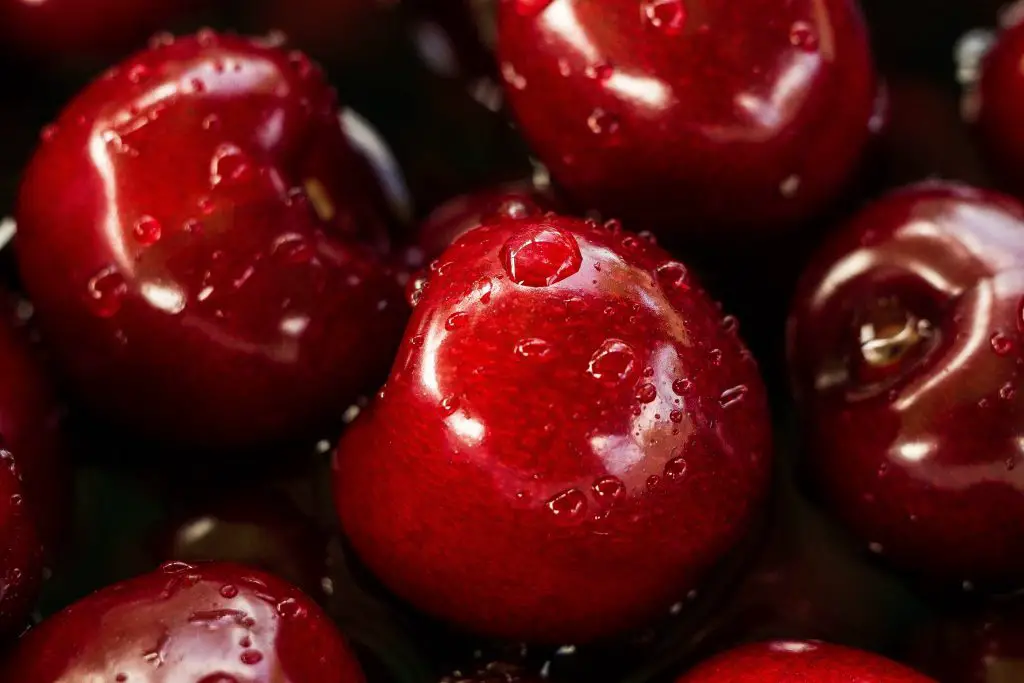
Once planted the tree should be pruned aggressively to reduce the size by around half. Ideally, cut above an outward-facing bud to encourage the formation of a vase-like structure that is open and will allow light and air into the center of the tree.
In the following seasons, any inward-facing branches need to be removed to maintain the desired shape. You will also need to reduce the height of the tree aggressively, to do this it is best to cut 1 to 2 ft (30 to 60 cm) above forks in branches to encourage the tree to continue to develop a vase-like structure.
Related Articles
How Many Cherries Does A Tree Produce? (Full Size And Espaliered Trees)
At What Temperature Should You Cover Fruit Trees?
7 Easy Steps To Creating An Orchard In Your Own Yard
